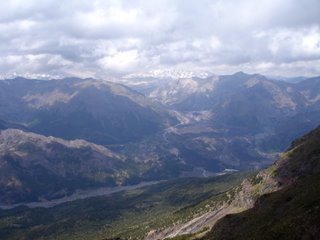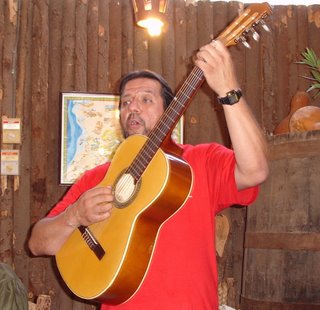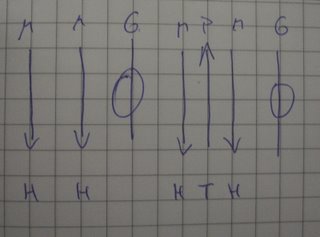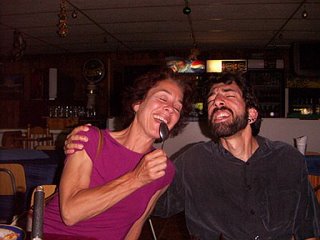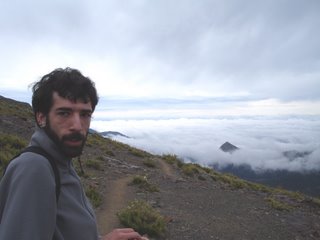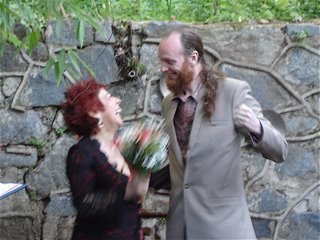In the first week of February, we took a kayaking trip through the fjords of
Parque Pumalín in southern Chile. We gathered a group of seven friends and enlisted the guiding services of
Alsur Expeditions. The trip was fantastic, although it was not without its moments of discomfort and stress. Before we could get our boats in the water, we had to first take a 10 hour bus ride from Chillán to Puerto Varas in a bus with broken air conditioning on a day when the temperature must have been hovering around 90 degress. It was brutal. Every hour or so we would pull into the bus terminal in another town where we would have 5 minutes to rush to the bathroom and back before the bus took off again. Another fun part of the bus trip was that when we got close to Puerto Varas they dropped us off out on the freeway outside of town rather than taking us into the center of town to the bus station. Luckily there was another person who got off at the same spot who helped us flag down a local bus to take the 10 minute ride into town.

We stayed at a nice hostel in Puerto Varas and assembled our group: Dan and Catherine, plus Shay and Stephen, our friends from Portland who were here in Chile for vacation. Also, Pancho, Catherine's cousin from New York, and Douglas, the husband of another Fulbright teacher in Concepción this year. Finally, Annie, a Fulbright teacher living on Robinson Crusoe Island off the coast of Chile.
Monday morning, our guide Tomás and a driver picked us up and we drove south for about 3-4 hours, in the rain, to get to Hornopirén, where we would put the boats in the water. There we also met our support boat and crew, Rudi and Beto. For one reason or another, we didn't actually get the kayaks into the water until about 5:00 pm, and we had several hours of paddling before nightfall, including a rather dicey channel crossing in wind and rain, our group rather spread out and only one guide to keep track of us all. The conditions were rough, and Pancho had never kayaked before, and Annie's boat was leaking and sinking low in the stern, drastically slowing her down. (We later patched the leak with duct tape.) Luckily, our destination was a hot springs on the island of Llancahue where we got to soak in the hot pool and spend the night in real beds in the hostel rather than camping out in tents.

I awoke several times during the night, each time hearing the rain coming down hard, and each time I turned over and thought, "ah, it will stop by morning...". Well, the next morning as we set out the rain was still coming down. Let me tell you, there is nothing quite as spirit-dampning as putting on cold, wet, paddling clothes. Hmmmm, maybe this wasn't such a good idea after all.

As we paddled that morning, the rain eventually stopped, but it was still pretty cold and cloudy. The spirits of the group remained high. It was great to be out on the water, invigorating. We joked with each other quite a bit, and the humor was of a decidedly dark variety ("terrible. no, horrible, that's what this is"), but no one whined! As the clouds began to lift we were able to see more and more of the incredible fjords all around us. The discomfort ceased to be an issue, and we surrendered to the beauty and the challenge of the day. Midday, we met up with Ludwig, the head guide, who had been detained on another trip and couldn't make it for the first day of our trip. After lunch, we continued paddling, pausing briefly to get up close and personal with a group of sea lions.

Eventually we arrived at the hot springs at end of the Cahuelmo fjord and set up camp. What an amazing place, with the hot tubs chisled out of solid rock, with natural hot spring water flowing in through channels in the surface of the rock. It was glorious, and we spent several hours in the water, warming our bones and cheering our spirits. This was one of the most beautiful spots that I have ever visited, yet the caretakers there said that they actually get very few visitors during a summer. Perhaps the cold and rain and the complete absence of a road contribute to this. Beto, our support boat crewman, was born and raised on the shores of this fjord, but the family homestead is long gone, abandoned and absorbed back into the rain forest. One troubling aspect of this place is the pending possibility that a road will be built along the coast to connect northern and southern Chile. There is a major fight going on right now in Chile over the placement of that road. If the road is built, this area will be completely changed.
That night in our tents at Cahuelmo, we again listened to the rain, but by morning it was only cloudy. We meant to get an early start, but slept in a little too late and ended up having a tricky exit as the tide dropped further and further, threatening to strand us in the mud flats. We had another day of paddling, with an afternoon of brisk winds and tricky waves. By about 4:00 pm we were glad to climb out of our kayaks and get on board the support boat to make the final channel crossing to Porcelana Creek and its hot springs deep in the forest. We spent two nights camping here, and enjoyed the hot springs morning and night. It was here that my sleeping bag ripped open in the middle of the night and we woke up in the morning with a tent full of feathers. We also took a hike one day to visit and tour the beekeeping and honey producing farm that is part of Parque Pumalín.

I could go on and describe each subsequent day of paddling and the wonders that we saw. But in truth, the memories that are most happily recalled to my mind are of the people on the trip. Rain or shine, the people sparkled. The memories of mountains and the waters and the birds and fish fade away, but the people remain in my heart and mind. Here are a few impressions of the members of our group:
- Our head guide Ludwig, who shared his long experience in the area and tested us frequently with politically incorrect humor. He also showed us the proper way to drink mate.
- Our guide Tomás, to whom we taught the proper use of the phrase, "bummer", and in more extreme conditions, "BUMMER, dude".
- Rudi, the captain of our support boat, a man of few words but impeccable judgment and knowledge of the sea. Also his son, Rudi Jr., who we could see taking over the controls of the boat occasionally with his father close by.
- Beto, the crewman of the support boat, who was always cheerful and always seemed to anticipate what needed to be done. Love those white boots, Beto.
- Carmen, who conjured three gourmet meals a day in the support boat's tiny galley and always went to the hot springs with us as well. The most memorable meal may have been the seafood stew made with mussels harvested that morning off the rocks, along with fresh caught salmon.
- Pancho, the ultimate sun-worshipper, did he ever stop smiling, even when the rain was pouring? Also notable, his statement that he only has two speeds for paddling, "slow and frantic"
- Douglas, seemed like the quiet type, until he started telling jokes. I will never forget the joke about the three construction workers and their lunches.
- Annie, kept us all in stitches, and translated our jokes into Spanish
- Shay, the energizer bunny of paddling, she just keeps on going.
- Stephen, whose positive outlook and good common sense kept us on an even keel even when the waves of discontent threatened to swamp the boats
- Catherine, who makes it easy to keep in sync while paddling together in the double kayak, and in life as well
In the end, as I look back on my travels through life, it is the people that I remember rather than the places.

To see more photos of the kayak trip, go to
http://www.slowtrain.placo.com/photos/kayakpumalin/To see a GoogleMaps map of some of the places from our trip, go to
Dan and Catherine's annotated map of Chile
 This is our last week of teaching here at Colegio Dario Salas and I find myself awash in conflicting emotions. I'm excited about going home to Portland. I'm relieved to not have to do any more lesson planning or, more importantly, not having to put on a tie to go to work (imagine, I'm 54 years old and this is the first job where I have had to wear a tie to work). I'm looking forward to not having to hold the attention of 45 high school students in a classroom where maybe 4 or 5 of them are really interested in learning English. Teaching is the hardest job in the world, no matter where you are in the world. I am filled with renewed respect for Catherine and her dedication to this profession. I admit that I have struggled at times this year with my students - they are noisy and not particularly hard-working. I have lost my temper on a few occasions, one time even accidentally shattering a plastic clipboard on a desk trying to get their attention. But as I prepare to leave and begin to say my goodbyes, it is the students that I feel closest to. We have tangled at times, but they have remained open and friendly, and this has often diffused my frustration into laughter. They retain a twinkle in their eye even when they are 'being bad'. Students who have been disruptive and uncooperative in class will greet you warmly in the hall just minutes later, and it is totally genuine. We see our students all over town, and they invariably greet us, "Hello Teacher! How are you?"
This is our last week of teaching here at Colegio Dario Salas and I find myself awash in conflicting emotions. I'm excited about going home to Portland. I'm relieved to not have to do any more lesson planning or, more importantly, not having to put on a tie to go to work (imagine, I'm 54 years old and this is the first job where I have had to wear a tie to work). I'm looking forward to not having to hold the attention of 45 high school students in a classroom where maybe 4 or 5 of them are really interested in learning English. Teaching is the hardest job in the world, no matter where you are in the world. I am filled with renewed respect for Catherine and her dedication to this profession. I admit that I have struggled at times this year with my students - they are noisy and not particularly hard-working. I have lost my temper on a few occasions, one time even accidentally shattering a plastic clipboard on a desk trying to get their attention. But as I prepare to leave and begin to say my goodbyes, it is the students that I feel closest to. We have tangled at times, but they have remained open and friendly, and this has often diffused my frustration into laughter. They retain a twinkle in their eye even when they are 'being bad'. Students who have been disruptive and uncooperative in class will greet you warmly in the hall just minutes later, and it is totally genuine. We see our students all over town, and they invariably greet us, "Hello Teacher! How are you?" 



























